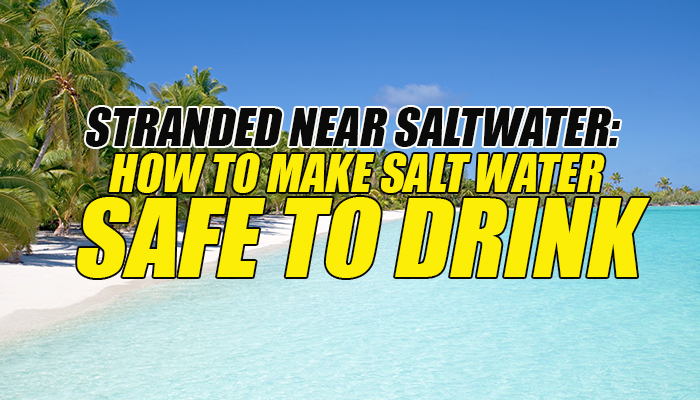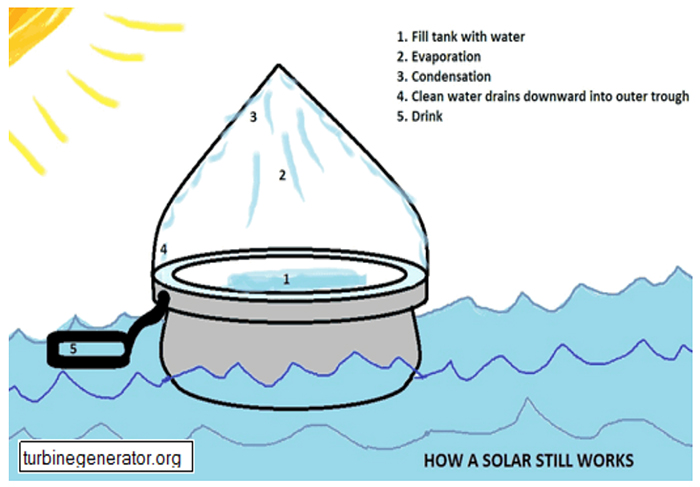
Desalination/distillation is a centuries old process and is still used today in many parts of the world. In ancient times sailors that were at sea for months used this process to convert seawater into potable water.
This very basic process that occurs in nature is responsible for the water (hydrologic) cycle. The sun’s rays supply the energy that causes water to evaporate from surface sources such as lakes, oceans, and streams. In a survival situation, the source would be water that you have collected whether it is seawater or a contaminated surface water source.
This evaporative process creates water vapor that once exposed to cooler air will re-condense to form dew or rain. We can, of course, create a so-called artificial system that will do the same thing, and the system is usually called a solar still (USGS, n.d.).

Photo Credit: TurbineGenerator.org
You can purchase an inflatable solar still (inflatable by mouth) and it would make an ideal piece of survival gear for your survival kit. A solar still will not only desalinate saltwater it will purify/distill any surface water source. Anyone that plans for a trip at sea should have an inflatable still packed away because if you are stranded on a boat in the middle of an ocean your only means of obtaining safe drinking water is by desalination of saltwater, or collection of rainwater.
The concept as described above is simple, and of course, if you become stranded without a solar still you can make your own, or use other methods to extract the salt from seawater.
One method is to collect steam from boiling seawater. This method is time-consuming and requires a substantial fuel source, a metal container in which to boil water, clean cloth preferably cotton, and of course, you need the ability to create a fire.
You would lay the absorbent cloth over most of the pot opening to collect the steam. You will need to wring the collected water from the cloth into a clean collection container. The water from the cloth is purified, distilled in other words. It is important that the cloth used is not contaminated with chemicals or toxins of any kind. The cloth will be hot so only drape it partially over the opening so there is a portion that can be held to wring it out.
This process will have to be performed a number of times to collect enough water to prevent dehydration. However, there will be plenty of water if you are near an ocean and if you have a good fuel source; you will get enough water to survive.
Another method is to hang a piece of plastic so the steam from the boiling water collects on the surface. As we stated before once the steam hits the cooler material, it will condense into water droplets. The plastic needs to be hung in such a way that the condensed droplets can drain into a collection cup. To help the process along you can cool off the plastic by applying water to the opposite side.
Any distillation process requires a cooler surface in which the vapor will collect or flow through in the case of copper tubing and condense. Seaweed or soaked cloth can be used to cool the plastic on the side that will not collect the steam of course.
You can also dig a solar still in the sand or soil. You would need plastic sheeting for vapor collection and condensation, and a collection vessel for the purified water.
Create a depression in the sand and pile the excavated sand along the sides to create a berm. Fill the depression with wet seaweed, green vegetation or pour seawater into the depression ensuring the sand is thoroughly soaked. Place the collection cup in the middle of the depression making sure it is not contaminated with the seawater. Lay the plastic over the depression and secure it along the sides by any means available. Punch a hole in the middle of the plastic over the cup and weight the center down with pebbles to form a depression for draining into the cup.
The sun heats the sand, vegetation and/or seaweed under the plastic causing very humid conditions and soon the vapor rising from the seaweed or water soaked sand will collect on the top side of the plastic, and once gravity takes hold the droplets will drain into the cup.
USGS. (n.d.). Retrieved 2017, from https://water.usgs.gov/edu/drinkseawater.html